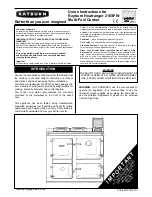
WARNING:
HOT SURFACES, use the tool supplied to
operate the appliance. It is recommended to use the
heatproof gloves supplied when raising the dome lids to
use the hotplate. Replacement gloves can be obtained
from the Aga Shop.
The firebox should be filled to the recommended level of
the bottom firebox door opening
and the firebox door
closed.
NOTE: WHEN BURNING ALL MANUFACTURED
FUELS OTHER THAN SUNBRITE COKE, THE
SECONDARY ARE SLIDE SHOULD BE SET IN A
CLOSED POSITION. A DEEP BED OF NEWLY
CHARGED FUEL ON A LOW FIRE WILL TAKE TIME
BEFORE HEAT REACHES THE OVEN, HOTPLATE
AND BOILER.
When burning Coal, Phurnacite and Anthracite, allow
several minutes for the new charge to ignite before
changing the flue chamber setting.
ONCE REFUELLING HAS BEEN COMPLETED, CLOSE
THE FIREBOX DOOR IMMEDIATELY AND OPEN ONLY
FOR REFUELLING CHARGES.
When burning coke, anthracite and other smokeless
fuels, logs or peat, the flue should be cleaned once a
month.
The use of coal may call for weekly cleaning. The
procedure is illustrated in Figs 11, 12 and 13.
Allow the fire to burn out, or it may be done with a low fire.
Open the chimney damper to its maximum. Remove the
flue chamber cleaning door. Brush the soot from the flue
pipe, letting it fall on top of the oven. Remove the plug
from the hotplate, rake the deposits forward, and push
into the firebox (Fig. 12). Replace parts removed, Riddle
the bottomgrate thoroughly, clear the ashpit and relight
the fire.
NOTE: THE COOKER IS DESIGNED AND INTENDED
TO BE UNDER CONTINUOUS FIRING AND WHEN NOT
IN USE, ASHPIT AND FLUE CHAMBER DOORS
SHOULD BE LEFT OPEN TO ENSURE FREE PASSAGE
OF AIR THROUGH THE APPLIANCE AND SO
AVOIDING PROBLEMS ARISING FROM
CONDENSATION.
Following a prolonged shutdown of the appliance perhaps
after the summer break, ensure the flue way is free from
obstruction prior to re-lighting.
Chimney Sweeping
Sweep annually and inspect the soot box at 3 monthly
intervals, remove any deposits.
NOTE: SWEEPS BRUSHES MUST BE OF THE TYPE
WITH THE WIRE CENTRES AND GUIDE WHEELS.
In the unlikely event that the appliance is not operating in
freezing conditions, the water must be drained from the
boiler to prevent frost damage.
Failing to maintain your cooker properly can lead to a
chimney fire. Chimney fires occur when combustible
deposits on the inner walls of the chimney ignite. These
combustible deposits on the inner walls of the chimney
ignite. These combustible deposits, called “creosote”, are
a natural by-product of wood burning. A fire hazard exists
if 1/4” of creosote (or more) coats the inner wallsof the
chimney.
Prevention
Chimney fires do not occur in clean, intact, properly
installed chimneys. Have a professional chimney sweep
clean and inspect your appliance at least once a year.
More frequent cleanings may be required, based on the
type of fuel burned, the type of appliance, and the
frequency of use. In general, an older appliance or one
that is used frequently, will require more than one clean
per year.
7
REFUELLING
FLUE CLEANING
Fig. 11
Fig. 12
Fig. 13
CHIMNEYS






























